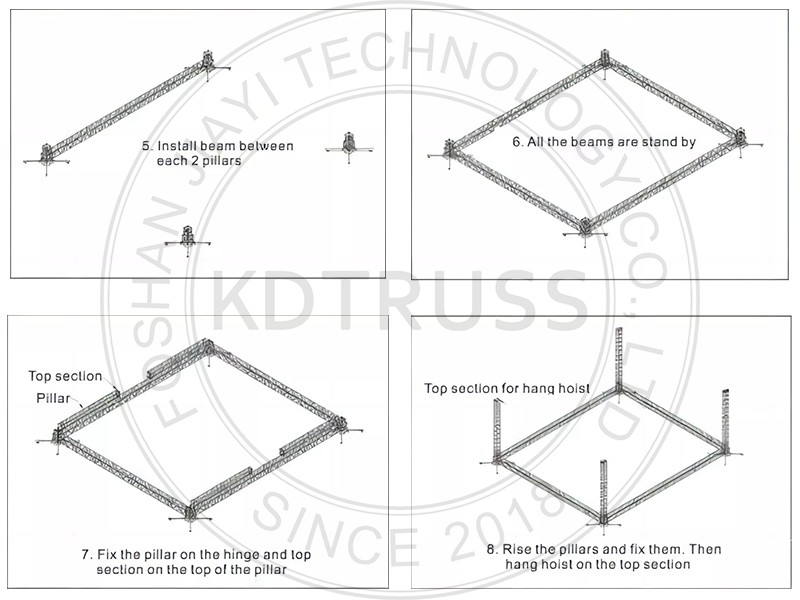What Are You Looking For?
The construction process you've outlined provides a clear step-by-step guide for erecting an aluminum alloy truss structure, which is a critical task in event setup due to its importance in ensuring stability and safety during various events.
Here's a concise summary and some additional points to consider:Aluminum Alloy Truss Construction Summary
1. Base Placement: Position four bases on the ground and adjust their legs for a level surface.
2. Diagonal Support Installation: Secure the diagonal supports to the bases to enhance stability. Make sure the supports are firmly attached and can handle the weight of the truss and equipment. Bolting the supports can add an extra layer of security. (2 per corner, totaling 8)
3. Reverse Head Attachment: Screw reverse heads onto the bases, ensuring their rotation direction matches the provided diagram.
4. Square Sleeve Installation: Fit square sleeves over the reverse heads.
5. Beam Assembly: Connect beams on the ground.
6. Beam-Square Set Linkage: Join the beams with the square sets, completing the beam assembly on the ground.
7. Column Truss Preparation: Connect column trusses horizontally, attaching one end to the reverse head with screws and the other to the cross arm, also connecting with a hoist for lifting.
8. Erecting Columns: Carefully raise the column trusses, avoiding excessive force, and secure the screws.
9. Beam Hoisting: Hook the hoist to the beam and lift it to align with the columns.
10. Beam Positioning: Use the hoist to maneuver the beam into position above the column heads.
11. Equipment Mounting: Install lighting and sound equipment onto the beam.
12. Final Height Adjustment: Elevate the structure to the desired height using the hoist.
13. Stabilization: Secure diagonal braces to columns and base cross arms, stabilizing the entire aluminum alloy truss structure.



Additional Considerations
• Safety First: Always wear appropriate PPE (Personal Protective Equipment), including hard hats, safety glasses, and gloves. Ensure all equipment is inspected before use.
• Load Calculation: Prior to construction, calculate the expected load (including equipment weight, wind loads, etc.) to ensure the truss system is adequately designed and rated for the job.
• Weather Conditions: Avoid setting up during adverse weather conditions such as high winds or storms to prevent accidents.
• Ground Stability: Check the ground condition and, if necessary, use appropriate ground anchors or weights to stabilize the bases.
• Professional Supervision: Especially for larger structures, having a professional supervisor or engineer overseeing the construction can ensure compliance with safety standards and structural integrity.
• Post-Construction Inspection: Before use, conduct a thorough inspection of the entire structure to verify that all connections are secure and the structure is stable.Following these steps and considerations will contribute to a safe and efficient construction of aluminum alloy truss systems for various events and applications.
Hi! Click one of our members below to chat on